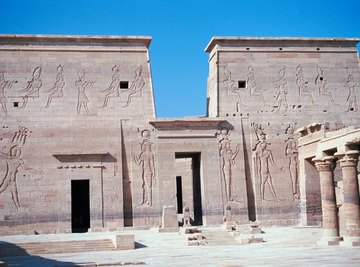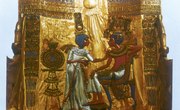
Life in ancient Egypt is a subject rich in myth. Knowledge of ancient life comes strictly from written accounts and archaeological evidence, and Egyptologists attempt to reconcile the truths of this evidence with the claims of the documents. While discoveries of gold-filled tombs have constructed a fanciful image of ancient Egyptian life, the reality is that the majority these people were poor and used whatever resources the land afforded them.
Reed Huts
Huts were the first types of homes built in predynastic and early dynastic periods in ancient Egypt, a time when the civilization was village-oriented and built on farming. Reed huts, constructed predominantly from papyrus reeds and animal skins, were relatively small, just large enough for a small family and a hearth. These huts were likely supported by pole frames of bound reeds or wood and were easily demolished by heavy rain, wind or sandstorms.
Mud Brick Houses
Once people realized that they could shape and dry into bricks the mud left behind by the Nile's annual flood, the ancient Egyptians began using mud to build sturdier houses. They mixed reeds and sand with the mud to form a stronger composite material and poured the mixture into brick molds to dry. Mud brick homes in ancient Egypt were simple structures for the poorer people: three-room houses with an outdoor kitchen and a flat roof. Wealthier families might also build a second floor accessible by ladders or stairs. Windows were small and rectangular to help keep out the sunlight while allowing the house to cool. The flat roof served as a living and storage space, and families often chose to sleep on their roofs, out under the stars.
Merchant Homes
During the New Kingdom, most of the homes of merchants and businessmen were still constructed of mud bricks, but they were larger -- either two or three stories -- and functioned as both businesses and households. Only the wealthiest merchants and artisans were able to afford stone houses. The roofs of these homes were still flat and often housed the kitchen as well as space for storage and sleeping. Middle-class people could also afford palm canopies for their roofs to shield that area from the sun. In Egyptian cities, such as El-Amarna, these houses were often built quite close to one another in dense neighborhoods.
Stone Mansions
While commoners lived in small, mud-brick houses, nobles lived in large stone homes. They often built these homes around large courtyards that contained gardens and pools. Nobles' homes often had bathrooms as well, although they did not have running water. Many affluent homes also had decorative scenery painted on the walls. Even though these homes were far more extravagant than peasants' homes, they still didn't have much furniture because wood was so scarce. Most furniture consisted of stone or mud-brick stools. Nobles, however, were able to afford mattresses to sleep on as opposed to the rugs used by peasants.
References
About the Author
Christopher Cascio is a memoirist and holds a Master of Fine Arts in creative writing and literature from Southampton Arts at Stony Brook Southampton, and a Bachelor of Arts in English with an emphasis in the rhetoric of fiction from Pennsylvania State University. His literary work has appeared in "The Southampton Review," "Feathertale," "Kalliope" and "The Rose and Thorn Journal."
Photo Credits
Jupiterimages/Photos.com/Getty Images
